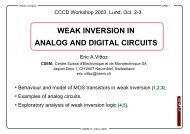Design of Antennas for Handheld DVB-H ... - Lunds tekniska högskola
Design of Antennas for Handheld DVB-H ... - Lunds tekniska högskola
Design of Antennas for Handheld DVB-H ... - Lunds tekniska högskola
You also want an ePaper? Increase the reach of your titles
YUMPU automatically turns print PDFs into web optimized ePapers that Google loves.
2 Background<br />
This chapter provides general in<strong>for</strong>mation about the different <strong>DVB</strong> standards and<br />
will give the needed knowledge about the system. Basic antenna theory will also<br />
be presented, to help the reader understand later discussions.<br />
2.1 Digital Video Broadcasting<br />
2.1.1 <strong>DVB</strong><br />
This part will give the reader an overview <strong>of</strong> the existing Digital Video<br />
Broadcasting – Terrestrial (<strong>DVB</strong>-T) system and the future <strong>DVB</strong>-H system.<br />
The analogue TV system used today has basically remained unchanged <strong>for</strong><br />
decades, with the colour TV as the only invention worth mentioning since the<br />
1960s. The European PAL system and the US NTSC system use the resolution <strong>of</strong><br />
625 lines respectively 525 lines, and the display is interlaced with only 25 or 30<br />
frames per second. Compared with today’s computer screen with resolution <strong>of</strong><br />
1280�1024 and at least 75 Hz frame rate. So, it is naturally that a transition to a<br />
digital system with higher resolution implies better picture and additional features<br />
[1].<br />
Until 1991 digital television broadcasting to the home was thought expensive and<br />
impractical to implement. During 1991 broadcasters and equipment manufactures<br />
discussed unify Europe with one standard <strong>for</strong> digital TV. The result was a group<br />
called European Launching Group (ELG) that expanded to include the major<br />
European media interest groups, both public and private, the consumer electronics<br />
manufacturers, common carriers and regulators. 1993 ELG renamed itself to<br />
Digital Video Broadcasting (<strong>DVB</strong>). The work in digital television, already<br />
underway in Europe, moved into top gear. It became clear that Digital Video<br />
Broadcasting–Satellite (<strong>DVB</strong>-S) and Digital Video Broadcasting–Cable (<strong>DVB</strong>-C)<br />
were delivering digital video broadcasting be<strong>for</strong>e <strong>DVB</strong>-T. This depends on fewer<br />
technical problems and a simpler regulatory.<br />
1997 the <strong>DVB</strong>-standards were adopted globally and became the benchmark <strong>for</strong><br />
digital television worldwide [2].<br />
<strong>DVB</strong> is an industry-led group with more than 300 broadcasters, manufacturers,<br />
network operators, s<strong>of</strong>tware developers and regulatory bodies. One <strong>of</strong> the main<br />
goals <strong>for</strong> the group is to develop open standards to prevent the digital TV to<br />
include as many standards as the analogue system (NTSC, PAL and SECAM)<br />
does. Since European Telecommunication Standards Institute (ETSI) adopted<br />
<strong>DVB</strong> as a standard, it has been implemented in many countries. An EU directive<br />
requires all country which will implement digital terrestrial TV broadcasting to<br />
3














